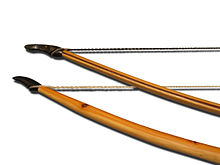The English longbow was a powerful medieval type of longbow (a tall bow for archery) about 6 ft (1.8 m) long used by the English and Welsh for hunting and as a weapon in warfare. English use of longbows was effective against the French during the Hundred Years' War, particularly at the start of the war in the battles of Sluys (1340), Crécy (1346), and Poitiers (1356), and perhaps most famously at the Battle of Agincourt (1415). However they were less successful after this, with longbowmen having their lines broken at the Battle of Verneuil (1424) though the English won a decisive victory, and being completely routed at the Battle of Patay (1429) when they were charged by the French mounted men-at-arms before they had prepared the terrain and finished defensive arrangements.
Longbows were very difficult to master because the force required to deliver an arrow through the improving armour of medieval Europe was very high by modern standards. Although the draw weight of a typical English longbow is disputed, it was at least 360 newtons (81 pounds-force) and possibly more than 600 N (130 lbf). Considerable practice was required to produce the swift and effective combat shooting required. Skeletons of longbow archers are recognisably affected, with enlarged left arms and often osteophytes on left wrists, left shoulders and right fingers.
 |
| Self (bottom);laminated (top) |
No English longbows survive from the period when the longbow was dominant (c. 1250–1450), probably because bows became weaker, broke, and were replaced rather than being handed down through generations. More than 130 bows survive from the Renaissance period, however. More than 3,500 arrows and 137 whole longbows were recovered from the Mary Rose, a ship of Henry VIII's navy that sank at Portsmouth in 1545.
Click here to see Other types of Bows


Comments
Post a Comment